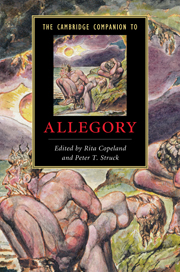Book contents
- Frontmatter
- Introduction
- Part I: Ancient foundations
- Part II: Philosophy, theology, and poetry 200 to 1200
- Part III: Literary allegory: philosophy and figuration
- Part IV: The fall and rise of allegory
- 15 Romanticism’s errant allegory
- 16 American allegory to 1900
- 17 Walter Benjamin’s concept of allegory
- 18 Hermeneutics, deconstruction, allegory
- 19 Allegory happens: allegory and the arts post-1960
- Further reading
- Index
16 - American allegory to 1900
from Part IV: - The fall and rise of allegory
Published online by Cambridge University Press: 28 January 2011
- Frontmatter
- Introduction
- Part I: Ancient foundations
- Part II: Philosophy, theology, and poetry 200 to 1200
- Part III: Literary allegory: philosophy and figuration
- Part IV: The fall and rise of allegory
- 15 Romanticism’s errant allegory
- 16 American allegory to 1900
- 17 Walter Benjamin’s concept of allegory
- 18 Hermeneutics, deconstruction, allegory
- 19 Allegory happens: allegory and the arts post-1960
- Further reading
- Index
Summary
Throughout its history in the Old World and the New, allegory has functioned in two dominant forms: as a style of writing or rhetoric but also as a way of reading, a hermeneutic. Literary allegory in America is bound up with philosophy to the point that Olaf Hansen, in his book on late nineteenth-century allegory, sees it as a substitute for America's failure to develop a distinctive school of philosophy. But the transformations of American religion, as Puritan orthodoxy gave way to a diversity of Churches and the emergence of a weak New England Unitarianism, also provide a forceful context for the development of both American allegorical hermeneutics and allegorical rhetoric. The 1850s in American literature has famously been termed “the American Renaissance,” following F. O. Matthiessen's 1941 book American Renaissance: Art and Expression in the Age of Emerson and Whitman. That Matthiessen referred to an American renaissance, a rebirth, to describe what he saw as the coming to maturity of American literary culture, rather than the birth of American literature, owes much to the colonial New England legacy of allegorical expression. Matthiessen describes the period 1850 to 1855 as “one extraordinarily concentrated moment of expression,” united by a commonality of themes, and particularly by the desire of his designated writers (Emerson, Thoreau, Hawthorne, Melville, Whitman, and Poe) to discover rhetorical means by which the word and the thing might become one.
- Type
- Chapter
- Information
- The Cambridge Companion to Allegory , pp. 229 - 240Publisher: Cambridge University PressPrint publication year: 2010
- 1
- Cited by



